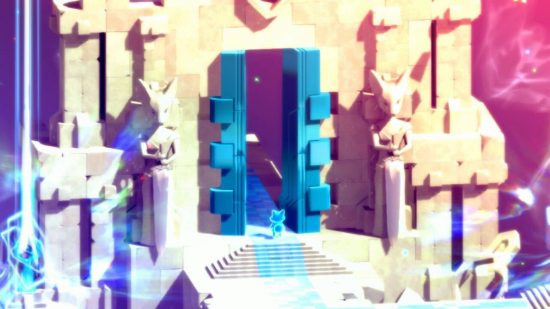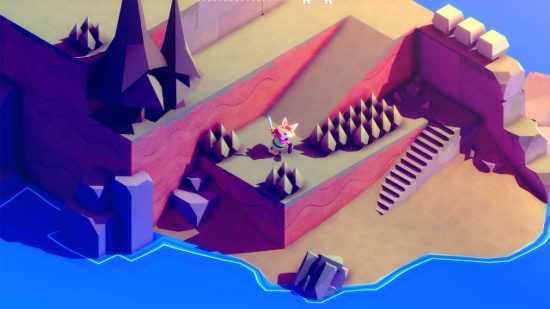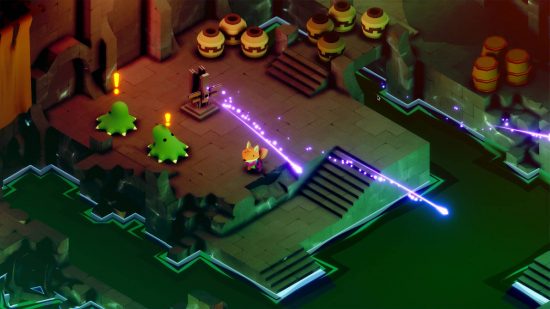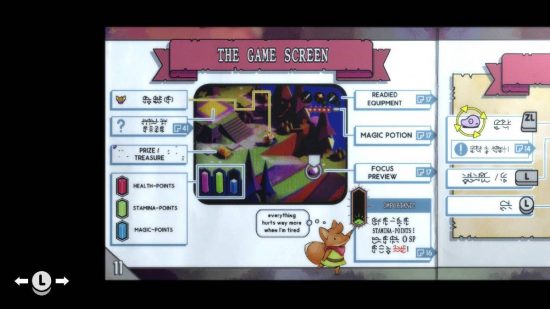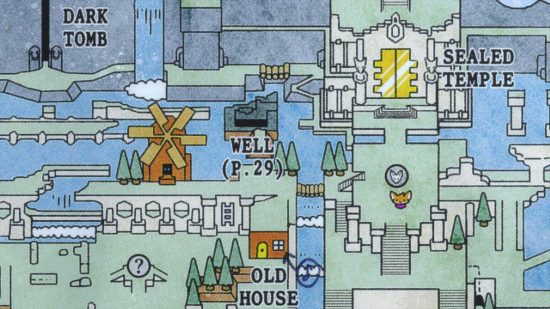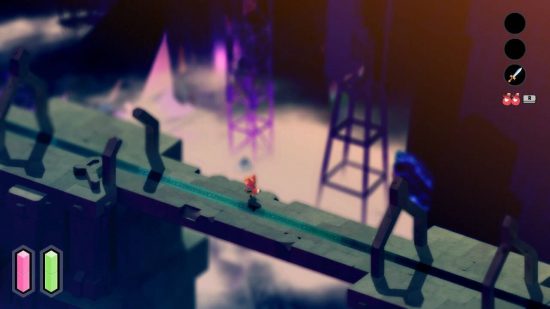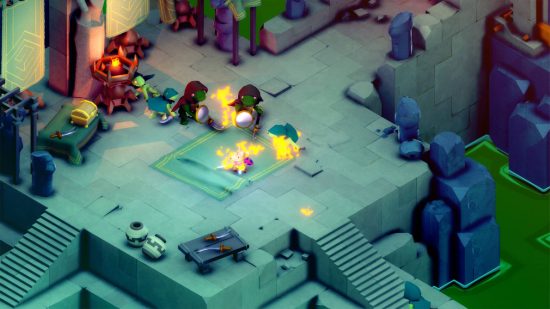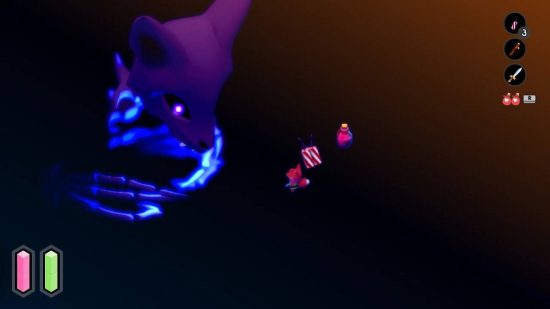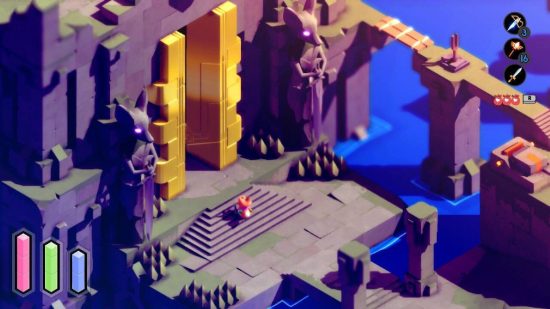Looks can be deceiving, and at a glance, Tunic looks like an almost unassuming adventure, a lighthearted romp reminiscent of early Zelda games and other whimsical titles. Well, you’re half right, but Tunic balances this brightly lit and gorgeous world with dark undertones and a surprisingly tough gameplay loop, to create a captivating game that doesn’t treat its players like children.
Tunic tells the wordless tale of one plucky fox, who washes up on the shore of a mysterious island, and quickly must explore its many intricate paths and corridors in search of answers. You quickly find some weapons and abilities, which come in handy as enemies litter this land, just waiting to take a swipe at this cute fox, like an angry house cat protecting its bins. So far, so Zelda.
In fact, the sunlit islands of Tunic, with their bright blue waters and beaming rays of light work, together with the stylised look of the titular fox and their tunic, deliver an art style somewhere between the toyetic Link’s Awakening from 2018, and Wind Waker from the Gamecube. It’s no doubt intentional, but the world itself features enough detail, decay, and distinct architecture in its many labyrinthian alleyways and island to feel like its own thing. It’s a charming mixture of low-poly 3D models and intricately illustrated elements that help to meld the childlike innocence with the more mysterious elements you discover later.
Because while it may seem sweet at first glance, Tunic’s secrets and combat betray those colourful aesthetics, as they hide a difficult and defiantly obtuse game that demands you earn its many secrets, rather than explaining them to you. This is where the Dark Souls inspiration comes in, and it’s the extra magic element that pulls Tunic up from the ranks of adoration and fanboy-esque homage to earn its place in the indie elite. Tunic doesn’t always escape comparison, and I wish it did a little more to separate itself in the combat department, but the world you can explore, and its many mysteries are something I’ll think about for a long time.
Speaking of combat, it’s one of the game’s pillars, and it does a satisfying job, even if I wish it had a touch more variety. While your fox starts out empty-handed, soon, you find a branch, a sword, a shield, and several magical items that expand your arsenal. The swing of your sword is slow and methodical, with the A button assigned to a dodge roll that requires a chunk of your stamina. Should you run out of stamina, you take more damage, so balancing your attacks and dodges is utterly essential.
While the first few enemies don’t demand much of you, quickly, the brutes start to swing weapons at you, shoot ranged attacks, while taller enemies use shields, which practically force you to learn how to dodge roll properly so you can attack them from behind. While there aren’t a lot of moves or weapons to use, the slow and contemplative nature of the combat makes it feel like a delicate dance. Anyone that just runs in swinging a sword is quickly reminded of why that doesn’t work in this game.
To counteract this feeling of helplessness, you can power your little fox up with a few consumable items that you can spend at the fox shrines, which also serve as a rest spot. Much like Dark Souls, these fox shrines save your progress, let you level up your stats, and reset the enemies in the open world. They’re few and far between though, and any deaths see you sent back to the last one you visited, no matter how far away it is.
This punishment for death, as well as the game’s wordless mysticism, make it a foreboding and often unforgiving world to explore. When you pick up items, a strange language is displayed with foreign symbols. Unfortunately, you can’t translate this, and instead, a lot of the early game is experimentation with these items. How you come across the explanation of these things is possibly my favourite element of the game and the glue that binds every other aspect.
As you explore Tunic, you discover pages of the game’s manual. Once you have a couple, pressing the – button will switch to a virtual representation of the manual, where you can switch between each of the pages you’ve collected so far. These are illustrated beautifully and with astounding attention to detail, as the game even lets you zoom in to inspect the tiniest feature, and every millimetre is made with dedication and detail. It also just looks gorgeous, with illustrated versions of the main protagonist, the many locations, and several enemies.
You can gawp at the many pages you collect, but also, these become essential for solving the many puzzles and problems that plague the overworld. Slowly but surely, you encounter a map which shows your position in the world with a little fox icon, a page that explains just how to use golden coins, or another page that gives a hint towards an item in a hidden location. Tunic is not a linear game. Instead, you explore until you meet any roadblocks and slowly unlock hidden ropes, gates, or secret passageways that give you handy shortcuts back to earlier areas like Metroid or Bloodborne.
It can feel daunting to wander around and get slapped around by enemies twice your size, or sent back after an encounter with one of the many brutal bosses waiting to test your skills. But, personally, the mystery elements kept me coming back, poking my nose a little further in, desperate to discover even more hidden alleyways and secret items so I could progress further. The game lets you find out things in your own time, and while it’s easy to get lost, the staunch opposition to handholding makes Tunic more reminiscent of classic games like Link’s Awakening or Majora’s Mask than some other recent Zelda-likes.
Adding to the mystery of the world is the strict isometric viewpoint. Similar to a title like Monument Valley or Hades, Tunic has a fixed isometric camera angle, and the only way to even nudge it a little is to lock it onto enemies. This is little help though, as most of the time, you need to swipe through hedges or creep round the ledges of the many fallen buildings in the hopes of discovering any of the secrets buried away. And there are many, many, secrets. Even toward the later game, I was blown away by smaller things I missed in the opening area, hidden away behind buildings and the camera angle, just waiting to be discovered.
It’s immensely satisfying once you have a few weapons and other techniques to go back through previous areas and comb them for all their worth. But it also further showcases that Tunic is an incredibly densely packed world that’s not afraid to ask you to actually search for its secrets. Subtle architectural hints help, or perhaps subtle things like shadows against a wall or a shallow patch of sand beneath the waves, but there are small environmental signs everywhere that beg you to explore them.
This is just as well, as you need to revisit a lot of areas, thanks to the bosses and the more difficult enemies you can stumble upon if you take a wrong turn. Early on, I accidentally snuck into an area I was woefully prepared for, and the denizens of that place were happy to show me why. Thankfully the bosses are all fairly well spaced out, and you can’t stumble across them accidentally. These change up the basic attacks of more common enemies and are great showcases for Tunic’s thoughtful combat.
My favourite is probably found in the garden to the west, as it starts to move away from just enemies with swords, and some wonderful designs match the inventive combat. In fact, I found a page of the manual nearby that recommended to me just how strong I should be to take them on. I hope people don’t mistake Tunic’s mythos and quiet encouragement for some sort of antagonistic difficulty. I think developer Tunic Team just know the magic of discovering something for yourself, the pre-internet days of playing your Game Boy for hours by sunlight, only to finally understand a puzzle and unlock a new weapon that decimates enemies you previously feared.
You need some patience to complete Tunic, but I think it rewards that patience handsomely thanks to its world rich with life, secrets, and interesting lore. However, if you’re strapped for time, there are some brilliant difficulty options. Players can choose to engage ‘no fail mode’, you can switch on ‘no stamina restrictions’, or if the game is just a touch too tough, you can bring combat difficulty down from standard to reduced. It’s because of these options that I’m happy to recommend the game to almost anyone, as thrill-seekers will adore the obtuse world and challenging difficulty, but I can also see even younger players glad to turn on no-fail mode and just explore a gorgeous game filled with smart environmental puzzles and secrets.
Tunic is a short adventure, clocking in at probably around twelve to fifteen hours for most people, and perhaps ten more to unlock everything possible and the ‘true’ ending. It never felt like the game outstayed its welcome, and while I had some frustrating moments where I felt truly lost or incapable of beating enemies, the slow expansion of both my own abilities and the game’s manual meant that very little of my time felt meaningless. I’d like to have seen some more variety or areas to explore, but I think that’s just greediness as opposed to the game not offering enough.
Now, one of my favourite elements of this game (which I’ve already really enjoyed if you couldn’t tell) is the sublime, ethereal soundtrack from Lifeformed that seems to blend crystalline leads synths and sweeping bass synth with delicate piano staccato hits. With warm motifs repeated over the colourful synth noises just bubbling with vivid energy, I felt continually both immersed and absolutely enamoured in this world. This is an early contender for my Nintendo Switch soundtrack of the year, a category I do not take lightly.
Finally, one element people have been analysing ever since its initial reveal trailer is performance. It’s clear that this port has to take a few shortcuts to squeeze onto Switch, as frame rate seems to attempt to lock at a solid 30 FPS but occasionally stumbles when many enemies or projectiles are on screen. It doesn’t seem anywhere near as bad in practice as the trailers may have hinted, showing that, as always, people need to remember that trailer footage is very often from a previous build.
There’s the occasional pop-in, especially when you save at a fox shrine and the world resets. This also brings the framerate crawling down, but as you’re saving, it doesn’t affect gameplay. Tunic uses a tight focus on the action and clever depth of field tricks to keep the frame squarely on what you need to see. You can occasionally use a telescope to get a better view of an area, and it feels like the game struggles a little here, but overall I think Tunic runs great and has made concessions in the right areas to keep the action tight and the visuals bright and clear.

Tunic is far from the only Zelda-like adventure on Switch, but it might be one of the very best that doesn’t star the tunic-clad Hylian himself. A fierce commitment to organic world-building works alongside the sickest virtual manual this side of Tony Hawk’s Pro Skater 3 to deliver a world that’s not only full of intricate and rewarding puzzles and secrets, but practically eggs you on to actually discover them for yourself. Married with satisfying, methodical combat, and a ridiculously beautiful soundtrack, even some technical issues and a sometimes punishing (though entirely optional) difficulty don’t stop this from being one of my indie highlights of the year.
Tunic review
Tunic boasts satisfying and challenging combat, as well as a beautiful world rich with hidden treasures and forgotten knowledge, and revels in slowly giving players the pieces they need to explore its every corner. A delightfully colourful visual language and a beautifully wistful soundtrack also help, bringing everything to life with earnest energy that delivers a sense of childlike wonder that very few games can achieve.
